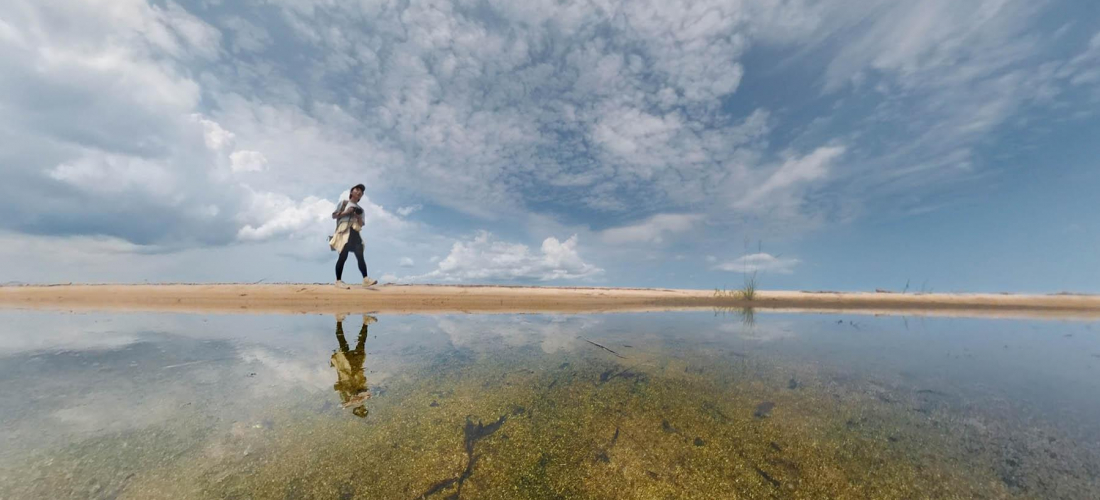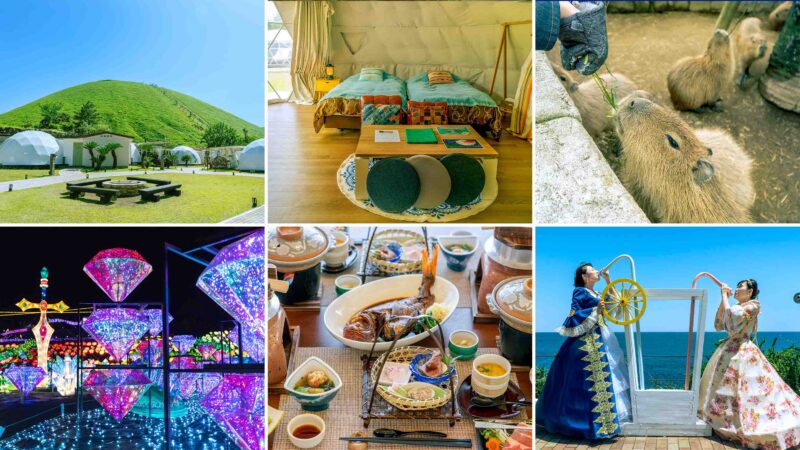
Izu Hotel Recommendations + Izu Travel Tips, From Capybaras to Glamping and Ocean Views
This article contains sponsored content.
From the capybaras of Izu Shaboten Zoo to Izu Granpal Park's famous light shows, and even cute Mt. Omuro, some of Izu's most popular attractions are most accessible when you stay near Izu-Kogen Station, so we've got all the tips for a great Izu trip and three convenient Izu accommodation options for you to choose from!
CONTENTS
Relax in Izu Among the Mountains, the Sea, and the Capybaras
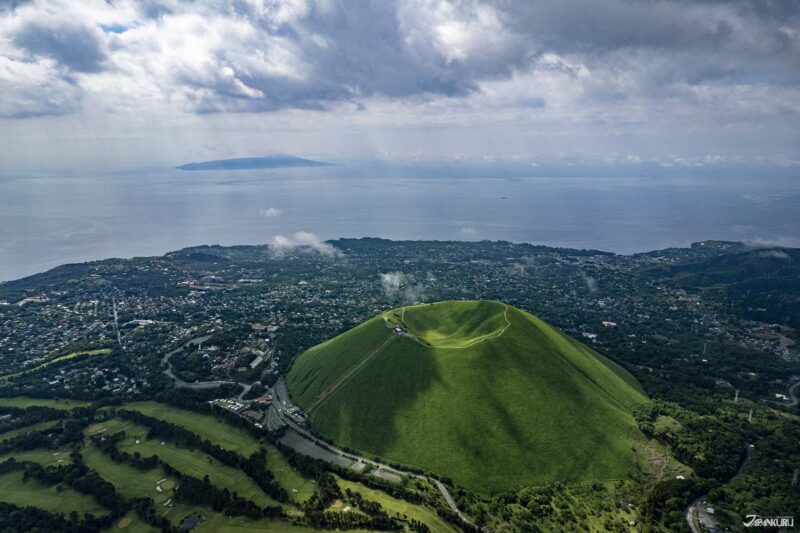


The Izu Peninsula could be called one of mother nature’s masterpieces, and the area is designated a UNESCO Global Geopark thanks to the spectacular scenery of the Jogasaki Coast and the volcanic mountainscapes. One of the most notable landmarks in the area is Mt. Omuro (which the Japankuru team has nicknamed “Mt. Matcha Pudding”), and at the foot of this unique mountain is another of Izu’s most popular attractions, Izu Shaboten Zoo. Between the picturesque natural scenery, and the unreasonably adorable capybaras (who have a penchant for taking warm baths), this part of the Izu Peninsula has long been a favorite among domestic tourists in Japan, and now travelers from around the world are starting to take note.

But the Izu Peninsula is a destination with more than a few unique attractions. Izu Granpal Park is a retro “activity park,” the kind that brings Japanese visitors straight back to their childhood years, and its nightly light shows are famous around Japan for their scale, detail, and unique themes. Not far away, the New York Lamp Museum & Flower Garden has an unmatched collection of antique Tiffany stained glass pieces, and a garden where visitors can dress up in princess costumes and take pictures.
With so much to see, you’ll want to find lodgings close to all of Izu’s sightseeing attractions so you can make the most of your time in Japan! So today we’ve not only got some tips and guides for how to maximize your time on the Izu Peninsula, but also three recommendations for where to stay in Izu! You won’t want to miss this retro Izu onsen ryokan, or some of the area’s most popular luxury glamping grounds.
Izu Accommodations ① Sky-Hill Hotel Izu Kogen: An Onsen Bath Beside the Capybaras and Ocean Views



Sky-Hill Hotel Izu Kogen is a hot spring hotel perched between Mt. Omuro and the Izu coastline, with freshly renovated rooms (redone in 2023) that still hold onto the area’s retro charm. The windows look out onto the city below, with a view of the sparkling ocean on the horizon. For guests visiting in February, the hotel makes an ideal viewing spot for the “Yamayaki” Mountain Burning Festival on Mt. Omuro!
But Sky-Hill Hotel is also an official hotel of Izu Shaboten Zoo, so it’s not only located directly next to the zoo grounds, but guests visiting the zoo even gain access to an exclusive direct entrance that leads right to the enclosure of the famous capybaras. You can literally walk from the hotel lobby to the heart of the zoo in under a minute! If you’re lucky, the animals might even come to you – the ostentatious peacocks that freely roam the zoo grounds sometimes wander beyond the zoo limits and decide to sun themselves on the hotel’s terrace instead.



The guest rooms at Sky-Hill Izu Kogen have always been popular due to the spectacular view of Izu visible from all the windows, but after the recent renovations, guests also come for the interiors as well – deliberately styled with a retro vibe for that classic onsen ryokan look. Even the appliances inside the room are carefully chosen to enhance the atmosphere, with modern refrigerators and electric kettles dressed up in the sleek vintage styles that have been trending in recent years. Most of the rooms offer a mix of Western and Japanese fittings, with two single beds alongside a separate Japanese-style space with tatami mat floors and traditional futon mattresses, resulting in rooms made to accommodate up to six people. The hotel’s Deluxe Rooms, with an attached living space, and their purely Western-style rooms can each sleep up to five. Couples or small groups of friends get plenty of space to stretch out, but even big families and other large groups can enjoy a comfortable stay.



As an onsen ryokan, Sky-Hill Hotel Izu Kogen has a large hot spring-fed bath looking out onto a verdant green landscape, as well as an attached sauna room. The hot spring water is lightly alkaline and said to leave bathers with glowing skin.
The hotel also has plenty of classic Japanese ryokan entertainment options, like a table tennis room. Wrap yourself up in your ryokan yukata after taking a dip in the onsen and enjoy a rousing game of table tennis to turn your hotel stay into something straight out of a Japanese anime. One might say that this is one of the true pleasures of an onsen trip in Japan.



Kids visiting Izu will be happy to see that Sky-Hill Hotel Izu Kogen has a children’s play space, while older guests might be more excited to spend some time in the hotel’s relaxation spaces, with inviting tatami floors, comfortable chairs, and a great view of the ocean. The 3rd-floor observation deck is also worth a visit, to see the tall green hump of Mt. Omuro nearby like a friendly green giant, along with an unobstructed view of Sagami Bay and the Seven Islands of Izu. When the weather is clear and visibility is good, you can even look in the opposite direction for a fabulous view of Mt. Fuji!

When staying at a Japanese hot spring hotel, the luxurious food is always something to look forward to. The dinner at Sky-Hill Hotel Izu Kogen is presented as traditional Japanese kaiseki cuisine, using seasonal local ingredients and a variety of presentation techniques to create elegant dishes full of color, fragrance, and flavor. As an add-on you can also order kinmedai (a variety of sea bream also called golden eye snapper), which is a local Izu specialty. (Children who aren’t quite ready to try Japanese fine dining can also choose a kids’ meal instead.)
Between the stunning views, comfortable accommodations, gourmet meals, and the luxurious hot springs (not to mention the location just a few steps away from Izu Shaboten Zoo), Sky-Hill Hotel Izu Kogen is a solid choice for making the most of your time in Izu.
Sky-Hill Hotel Izu Kogen (スカイヒルホテル伊豆高原)
1317-624 Futo, Ito, Shizuoka
Check-in/Check-out: 15:00 – 20:00 (~17:00 if you have dinner reservation) / ~10:00
Official Website (jp)|Reservations
Izu Accommodations ② Izu Shaboten Village Glamping: Luxury Camping at the Foot of Mt. Omuro
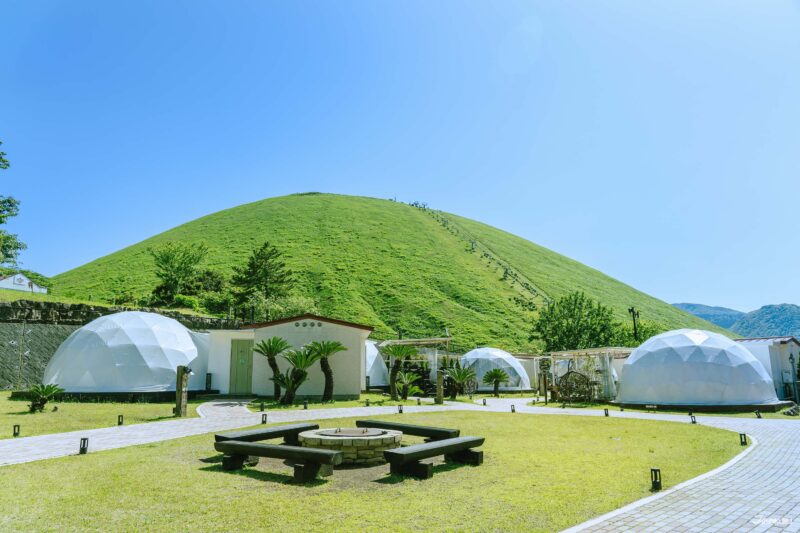


Glamping grounds provide guests with a refreshing taste of the outdoors and a swanky space to spend the night, which is why they’ve become a popular choice in recent years among travelers who want to relax and enjoy some of the fun of camping in nature without any of the inconvenience. Izu Shaboten Village Glamping offers all that and a fantastic view of Mt. Omuro, being located right at the base of the conical mountain. As an official Izu Shaboten Zoo accommodation facility, the whole “village” also has some cute animal easter eggs, like the signs on each door featuring popular friends from the nearby zoo. (The capybara and the red panda are two fan favorites.)

The whole style of the Izu Shaboten Village Glamping ground is playful and fun, and the spacious domed tents are decorated with colorful linens and patterned carpets, dotted with a bohemian selection of cushions and beanbags. But perhaps the most ingenious amenity is the ensuite bathroom that come attached to each tent! Guests who appreciate their little luxuries will be happy to hear that each glamping tent comes equipped with its own toilet room and a bathtub complete with running water – a lifesaver on rainy nights and chilly mornings!

The domed tents come furnished in either a Japanese-Western style that can accommodate up to five people, or a more traditional Japanese style with tatami mats and futons, which sleeps up to six. They’re ideal as a romantic getaway for couples, but they’re also popular among families and friends planning group trips!


One of the highlights of this luxury camping experience is the rather opulent BBQ dinner, and a refreshing breakfast out on the deck! Izu Shaboten Village Glamping has a couple different meal plans to choose from, but each of them includes seasonal and local Izu produce, along with a lavish selection of meats and seafood, which you can grill to perfection on the grill outside each tent. Vegetarians and other guests with dietary restrictions can also choose to pick up ingredients for their BBQ at a nearby supermarket, so they can grill up their favorite foods while enjoying Izu’s cool sea breezes. In the morning, breakfast is delivered to each tent in a box that includes sandwiches and fresh salads, fruit and yogurt, plus drinks like coffee and milk!

As you might expect of official Izu Shaboten Zoo accommodations, this glamping ground is only about three minutes from the zoo on food. The Mt. Omuro ropeway station (with a chairlift that takes you to the top of the mountain) is equally close, in the other direction. So if you want to maximize your time enjoying Izu’s fresh air, and you like idea of camping in luxury, Izu Shaboten Village Glamping might be the perfect place to stay when you visit Izu.
Izu Shaboten Village Glamping (伊豆シャボテンヴィレッジグランピング)
1317-584 Futo, Ito, Shizuoka
Check-in/Check-out: 15:00 – 18:00 / ~11:00
Official Website (jp)|Reservations
Izu Accommodations ③ Izu Gran Village Glamping: Peaceful Privacy and Luxury Relaxation


All ready to go glamping in Izu? There are actually a couple great options in the area, and our second recommendation is Izu Gran Village Glamping! If you plan to visit Izu Granpal Park for the day, or even just stop by in the evening for the extravegant light show, this nearby glamping option is especially convenient. The grounds at Izu Gran Village offer plenty of room to stretch out, with each tent located far enough from the others to provide a sense of privacy, and the overall atmosphere is a little more mature. Compared to the whimsical decorations at Shaboten Village, this other glamping ground offers a more mellow feel, with an unhurried vibe that gives you plenty of time to enjoy your surroundings.


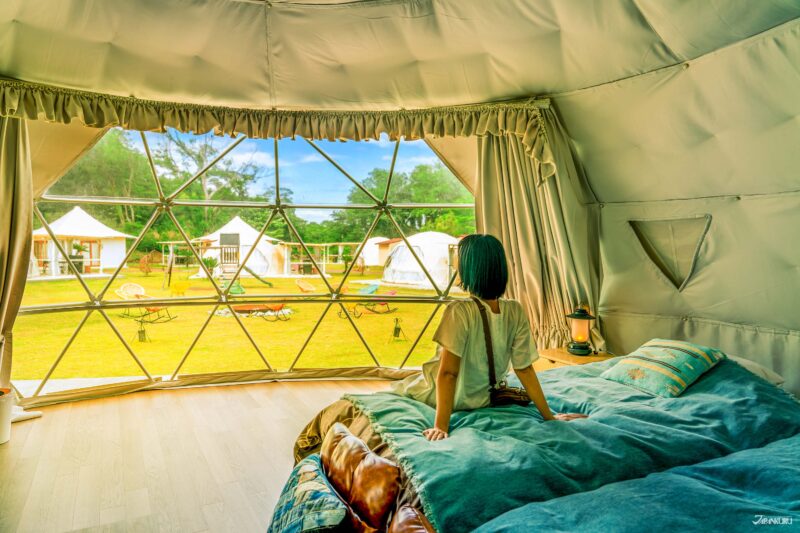

The interior of the tents at Izu Gran Village Glamping feels just as roomy as the spacious grounds, using simple furnishings with a slightly retro outdoorsy feel. The vintage-looking refrigerators (the same cool style as in Sky-Hill Hotel) and other practical amenities add to the sense of design, but the bathrooms go in a slightly different direction. Just like our last glamping ground, the tents at Izu Gran Village also have their own attached bathrooms, but these are startlingly glamorous – each one comes equipped with its own clawfoot bathtub! Enjoy a relaxing soak in the luxurious tub, and then relax in your room, looking out at the green lawns. (Tents near the central bonfire have an especially good view!)


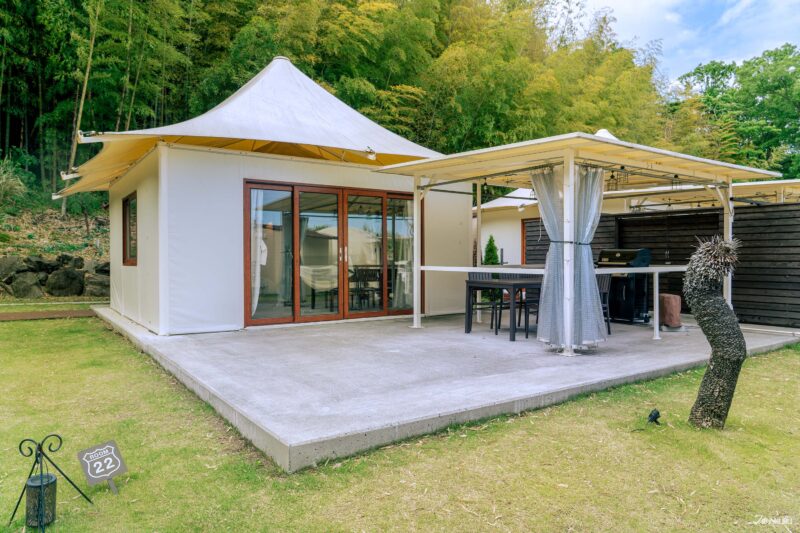
Izu Gran Village Glamping has a selection of the large domed tents that have become strongly associated with glamping, but they also have a handful of even larger square tents that seem to verge on cabins. No matter which kind of tent you choose, however, all guests can reserve a time to use the private sauna for an additional fee. Just ask at the front desk – you can even rent a convenient towel wrap to use while steaming.

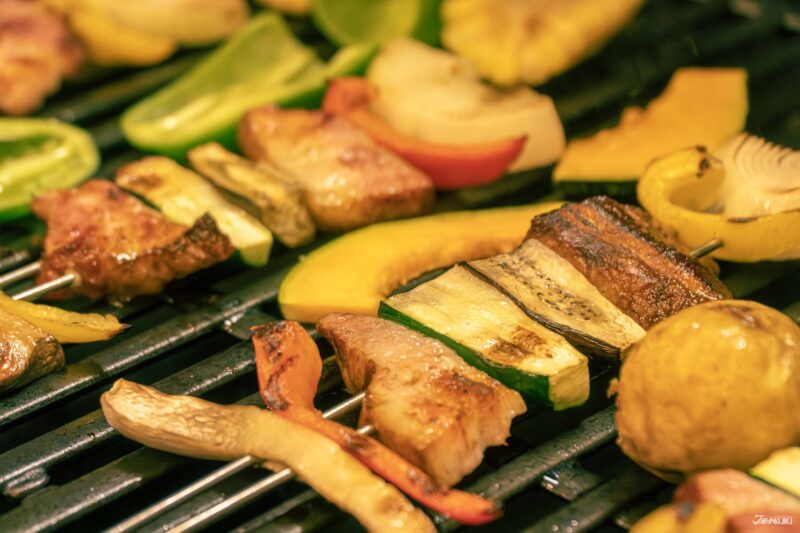

This glamping ground also offers decadent dinners options, and their basic BBQ plan provides guests with a selection of fresh seasonal vegetables to throw on the grill, French bread, and huge skewers packed end to end with meat and veggies – the full menu includes local “Fujinokuni” pork, chicken thighs, beef shoulder, and seafood! Upgrade to their luxury plan for additional local and seasonal ingredients like Shizuoka Ashitaka beef, and salad with Mt. Fuji salmon. (You can even choose to splurge for extra turban shells or spiny lobster!) Dinner finishes with fresh fruit and marshmallows for s’mores! And in the morning, you can head back out onto the deck for fresh air and a breakfast of fresh produce and all the ingredients to make your own toasted sandwiches.



One of the joys of staying at Izu Gran Village Glamping ground is making the most of the self-service drink bar next to reception. From check-in through dinner time, guests can enjoy unlimited drinks from the machines, including coffee, soft drinks, juice, soft-serve ice cream (!?), beer, lemon sours, and both red and white wine. That’s right, this drink bar even includes ice cream and free-flow beer and wine! If you have a taste for the finer things and prefer more premium drinks, there’s a selection of bottles available for an additional fee, as well.
All in all, both Izu Gran Village and Izu Shaboten Village offer guests a luxurious camping experience, but they’re a bit different as well. If a little extra privacy and a relaxed, sophisticated camping ground sound just right for your trip to Izu, then Izu Gran Village Glamping might be the right choice for you.
Izu Gran Village Glamping (伊豆グランヴィレッジグランピング)
1089-5 Futo, Ito, Shizuoka
Check-in/Check-out: 15:00 – 18:00 / ~11:00
Official Website (jp)|Reservations
A Quick Guide to Izu’s Best Attractions
This area of Izu, accessible from Izu-Kogen Station, is where you’ll find some of the peninsula’s most popular sightseeing spots. We’ve put together a simple guide to help you check out all the Izu must-sees!
Mt. Omuro: A Matcha Pudding with Breathtaking Views!?



Mt. Omuro is a local Izu landmark, and an officially designated natural monument of Japan, shaped like an upside-down rice bowl (or, you might say, like a Japanese pudding) due to its origins as a monogenetic volcano (the kind that only erupts once)! The cinder cone’s distinct shape is emphasized by the lack of tall vegetation on any of its sides, with rich green grass and small bushes creating smooth sides that look good enough to dig a spoon into. This unique look is maintained in part thanks to the local tradition of yearly “Yamayaki,” a mountain-burning festival that has been happening in this spot for somewhere around 700 years! Huge crowds still arrive at the mountain every February to see the glowing line of flames lick the sides of the mountain and turn it an ashy black.
On days when Mt. Omuro isn’t being set on fire, visitors can take the Mt. Omuro Lift up the side of the mountain, and walk the path around the lip of the volcano for some pretty spectacular views in all directions. Look out at the water to see Sagami Bay and the Seven Islands of Izu, and (when the weather cooperates) take in the view to the northwest for a unique view of Mt. Fuji.
Mt. Omuro Lift (大室山登山リフト)
672-2 Ike, Ito, Shizuoka
Hours:
Mar~Sep: 9:00 – 17:00 (final return trip at 17:15)
Oct~Feb: 9:00 – 16:00 (tickets sold until 16:15)
New Year’s Day: 5:40 – 8:15 (special hours for the year’s first sunrise, tickets only available until 7:00)
Directions: Take the Izukyu Line to Izu-Kogen Station, then take the Tokai Bus bound for Shaboten-koen to the final stop (about 15 min).
Official Website (en)
Izu Shaboten Zoo: A Land of Capybaras & Cacti



Izu Shaboten Zoo, famous overseas for its capybaras who love to soak in their open-air bath, is an animal and plant paradise with around 140 species of animals and close to 1,500 species of cacti and other succulents. Some of the animals have free range of the park, like the peacocks and squirrel monkeys, and others are free to go where they please within certain areas, like the kangaroos and emus, which allows visitors to get up close and personal with the animals. This zoo makes it feel like these animals aren’t just in our world – we’re entering theirs! The capybaras have become an international phenomenon thanks to their popularity online, but many of the zoo’s cutest residents have become stars in their own right, like the fennec foxes, red pandas, ring-tailed lemurs, and even the kangaroos.
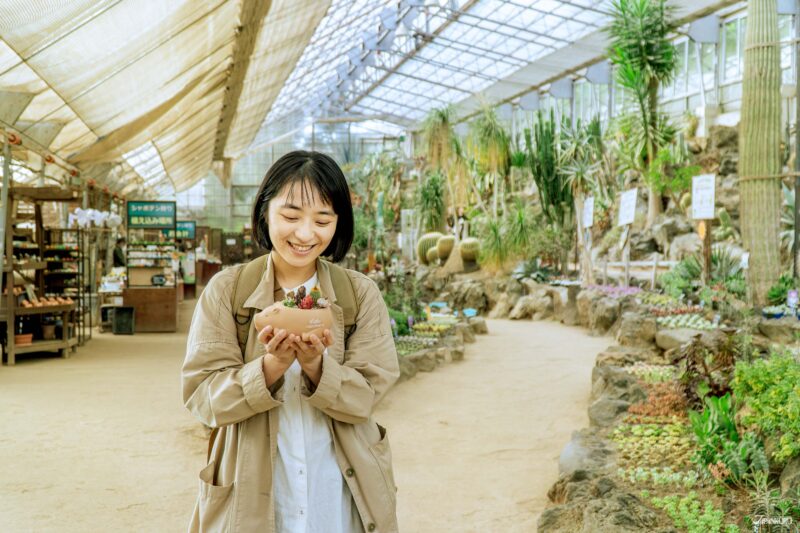

“Shaboten” isn’t just a name – it actually means “cactus” in Japanese. So in addition to all the animal residents, Izu Shaboten Zoo also has a huge cactus greenhouse! The huge variety of cacti and other succulents gathered in one place is undeniably impressive, and many visitors also take home a potted cactus or two via the unique “cactus harvesting” area where you can dig up and pot any number of different succulents together for a fee.
When you’re ready for lunch, you absolutely should not miss the zoo restaurant, Gibbontei Forest Animal Restaurant. The fabulous decorations have earned the restaurant its fair share of internet fame, from the pink flamingos flying overhead to the frankly adorable giant capybara and red panda stuffies that occupy empty seats at every table. Even the food is fun – we recommend the capybara burger, which is almost too cute to eat. (Almost.)
Izu Shaboten Zoo (伊豆シャボテン動物公園)
1317-13 Futo, Ito, Shizuoka
Hours: 9:30 – 17:00 (hours may vary season to season, final admission 30 min prior to closing)
Directions: From Izu-Kogen Station, take the Tokai Bus to Shaboten-koen (about 20 min), or take a taxi (about 10 min).
Official Website (jp)
The Jogasaki Coast: Picture-Perfect Seascapes Straight From a Postcard

This picturesque portion of the Jogasaki Coast is a classic Izu destination, with visitors coming to see the craggy cliffs that were formed from the lava flows that erupted from Mt. Omuro 4,000 years ago, eroded over the millenia into the shapes we see today. The various paths and rocky trails along the water’s edge add up to a total of around 9 kilometers, but plenty of people just come for a quick look around and a breath of fresh sea air. Don’t miss the delicate Kadowaki Suspension Bridge, an elegant silhouette against a backdrop of blue sky and sea, and keep an eye out for the joyous swooping of little swallows and sparrows!
Jogasaki Coast (城ヶ崎海岸)
Futo, Ito, Shizuoka
Directions: Take the Izukyu Line to Kinosaki-Kaigan Station, and walk for about 35 min
Official Page (jp)
New York Lamp Museum & Flower Garden: Antique Stained Glass & Princess Dreams



If you have an interest in interior decorating you might know of “Tiffany lamps,” but we’re certain you’ve heard of the jeweler Tiffany & Co. before! It turns out Louis Comfort Tiffany, the son of Tiffany & Co. founder Charles Lewis Tiffany, was the stained glass artist behind the famous stained glass lamps, clearly inheriting a sense of design and craftsmanship. The antique stained glass pieces created by hand in the New York Tiffany Studio around the turn of the century are now coveted by art and design lovers around the world, and the New York Lamp Museum displays a priceless collection of around 80 antique stained glass pieces made by Tiffany and the other artisans in the Tiffany Studio in New York. The museum attracts plenty of art lovers and Tiffany collectors from overseas, but the gorgeous stained glass lamps, window panels, and other unique pieces are certainly worth a look even if you know nothing about Tiffany!


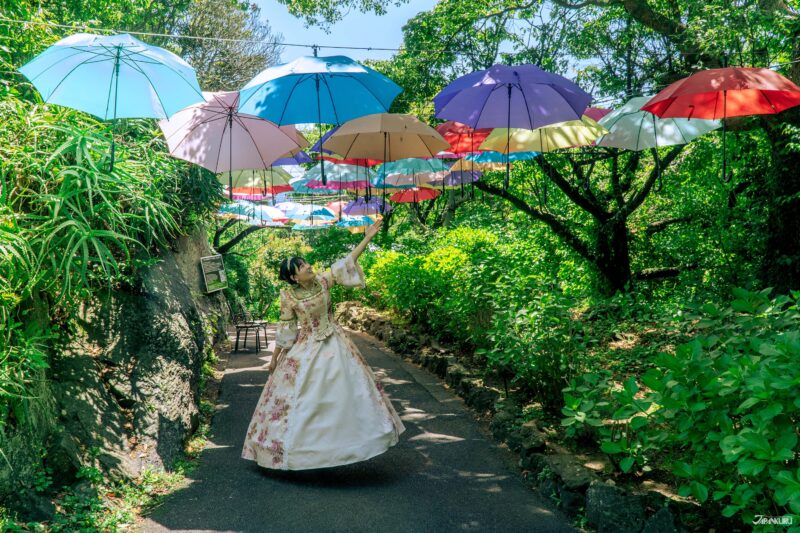
The museum is situated on Izu’s coast, with more lovely views of the water, and visitors can also enjoy a stunning flower garden all around the museum building! The terraced garden includes a variety of different herbs, trees, and of course flowers, and the “ice tulips” that bloom from late December through January look particularly exquisite blooming in front of the blue seascape. There are lots of great picture-taking spots throughout the grounds, and the gift shop offers the very unique option of dressing up like a fairytale princess while you visit the museum and garden! (Just ask the staff in the shop to rent a dress and a tiara!) If you’d rather sit back and relax, the cafe in the museum annex has outdoor seating with a fabulous view. (Princesses must change out of their regalia before eating and drinking in the cafe!)
New York Lamp Museum & Flower Garden (ニューヨークランプミュージアム&フラワーガーデン)
841-1 Futo, Ito, Shizuoka
Hours: 9:30 – 17:00 (hours vary season to season, final admission 30 min prior to closing)
Directions: From Izu-Kogen Station take the Tokai Bus bound for Izu-kaigan-koen to the final stop (about 10 min).
Official Website (en)
Izu Granpal Park: Retro Vibes, Dinosaurs, and Brilliant Light Shows



Izu Granpal Park has been a beloved part of the Izu landscape for nearly 60 years, but over the years this amusement park has changed a lot to keep things fresh and interesting for visitors young and old. The ambience is retro, but many of the attractions are much newer additions, and these days some of the most popular reasons for visiting include the dreamy light shows after dark, and the animatronic dinosaurs that feel rather Jurassic. In Japan, “illumination” light shows are fairly common throughout the colder months of the year, but Izu Granpal Park is famous for firing up their glittering “GRANILLUMI” light show after dark throughout the spring and summer as well! (Check the official website for details.) The otherworldly light displays have repeatedly earned first place in nationwide Japanese rankings, which is no small feat. And those dinosaurs? Not only can you walk through a world of extinct reptiles at your own pace, but you can also ride go-karts through their territory! After dark, even the dinos get their own cool light displays, creating a totally different feeling from during the day.

Visitors looking for thrills might also want to take a ride in the Ninebot Mini Segway course, or even check out the zip line. The zip line is open even after dark, which means you can whip through the air while admiring the sparkling lights of GRANILLUMI all around you!
Izu Granpal Park (伊豆ぐらんぱる公園)
1090 Futo, Ito City, Shizuoka
Hours: 9:30 – 17:00 (hours vary season to season, evening GRANILLUMI tickets are sold separately)
Izu Kogen GRANILLUMI Dates: Nov. 11 2023 – Aug. 31, 2024 (closed on some weekdays from Apr. 8, 2024; check the official GRANILLUMI website for further opening details)
Directions: From Izu-Kogen Station, take the Tokai Bus (about 10 min).
Official Website (jp)
How to Get to Izu

The accommodations and sightseeing we’ve looked at today have all been concentrated around, and easily accessible from, Izu-Kogen Station. To get from Tokyo to Izu quickly and comfortably, we recommend taking JR EAST’s Limited Express Odoriko train, which runs directly from Tokyo Station to Izu-Kogen Station! If you want to add a little luxury to your trip, you can even book a seat on the “Saphir Odoriko,” which offers an elevated transportation experience.
Another good option is to take advantage of the JR TOKYO Wide Pass, which the JR EAST Group offers exclusively for foreign travelers exploring Japan. Adults pay 15,000 yen for a three-day pass (consecutive) that can be used for unlimited rides on both JR EAST and other railway lines within a designated area including Tokyo. This even includes shinkansen and shinkansen and limited express trains, like the Odoriko! (If you want to ride on the premium Saphir Odoriko, an additional upgrade fee is required.) We recommend making a rough calculation of transportation costs while planning the itinerary for your trip, so you can see what the best deal is for your travel plans!

Once you get to the Izu-Kogen Station area, the most convenient way to travel (especially for groups) is to rent a car, as it gives you the most freedom of movement. If you don’t have a driver, or would simply rather use public transportation, getting around with a combination of buses and occasional taxis is also totally doable! The Tokai Bus is especially useful, as it runs from local train stations to many of the area’s most popular attractions. The Tokai Bus offers some useful bus pass options, the Izu-Kogen/Jogasaki 1 Day Pass and the Ito/Izu-Kogen 1 Day Pass, and between the two of them you can pretty much get to all the accommodations and sightseeing spots above. You can pick up these passes at Izu-Kogen Station, or you can buy them online through the EMot online ticketing service. (The Ito/Izu-Kogen Pass is also available on KKDay.)
Find Relaxation, Stunning Natural Scenery, and Even Adorable Animals in Izu

From Japan’s cutest capybaras to breathtaking views of natural seascapes and man-made light shows, Izu has plenty to offer travelers visiting Japan, on a first time trip or a fiftieth! And when it comes to staying in Izu, we’re pretty sure you won’t regret staying in either a onsen hotel with retro stylings, or each of our two glamping recommendations. The travel tips above only begin to cover all the Izu Peninsula has to offer, and if you want to see even more, you can check out one of the best viewing points for Mt. Fuji in all of Japan, or even explore the early cherry blossoms and historic streets of the Kawazu-Shimoda area! On your next trip to Japan, don’t forget to add Izu to the itinerary!
For more info and updates from Japan, check Japankuru for new articles, and don’t forget to follow us on X (Twitter), Instagram, and Facebook!





 >> Find out more at Japankuru.com! (link in bio)
#
>> Find out more at Japankuru.com! (link in bio)
#





 The Robot Restaurant is gone, but the Samurai Restaurant is here to take its place. Check it out, and don't forget your coupon!
The Robot Restaurant is gone, but the Samurai Restaurant is here to take its place. Check it out, and don't forget your coupon!
 신주쿠의 명소 로봇 레스토랑이 사무라이 레스토랑으로 부활! 절찬 쿠폰 발급중
신주쿠의 명소 로봇 레스토랑이 사무라이 레스토랑으로 부활! 절찬 쿠폰 발급중
 18歲以上才能入場的歌舞秀,和你想的不一樣!拿好優惠券去看看~
#tokyo #shinjuku #samurairestaurant #robotrestaurant #tokyotrip #도쿄여행 #신주쿠 #사무라이레스토랑 #이색체험 #할인이벤트 #歌舞伎町 #東京景點 #武士餐廳 #日本表演 #日本文化體驗 #japankuru #japantrip #japantravel #japanlovers #japan_of_insta
18歲以上才能入場的歌舞秀,和你想的不一樣!拿好優惠券去看看~
#tokyo #shinjuku #samurairestaurant #robotrestaurant #tokyotrip #도쿄여행 #신주쿠 #사무라이레스토랑 #이색체험 #할인이벤트 #歌舞伎町 #東京景點 #武士餐廳 #日本表演 #日本文化體驗 #japankuru #japantrip #japantravel #japanlovers #japan_of_insta
 코지마 x 빅 카메라 쿠폰으로 일본 가전 제품 쇼핑하기
#pr #japankuru #japanshopping #kojima #biccamera #japaneseskincare #yaman #dji #osmopocket3 #skincaredevice #日本購物 #美容儀 #相機 #雅萌 #日本家電 #일본여행 #면세 #여행꿀팁 #일본쇼핑리스트 #쿠폰 #일본쇼핑 #일본브랜드 #할인 #코지마 #빅카메라 #japankurucoupon
코지마 x 빅 카메라 쿠폰으로 일본 가전 제품 쇼핑하기
#pr #japankuru #japanshopping #kojima #biccamera #japaneseskincare #yaman #dji #osmopocket3 #skincaredevice #日本購物 #美容儀 #相機 #雅萌 #日本家電 #일본여행 #면세 #여행꿀팁 #일본쇼핑리스트 #쿠폰 #일본쇼핑 #일본브랜드 #할인 #코지마 #빅카메라 #japankurucoupon
































 Oita Hello Kitty Airport
Oita Hello Kitty Airport  Lands April 13th
Lands April 13th












